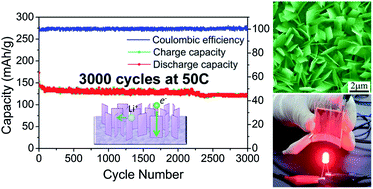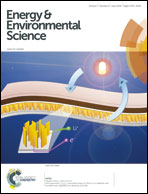Self-supported Li4Ti5O12 nanosheet arrays for lithium ion batteries with excellent rate capability and ultralong cycle life†
Abstract
Facile fabrication of well-aligned Li4Ti5O12 (LTO) nanosheet arrays grown directly on conductive Ti foil was achieved by hydrothermal growth in LiOH solution. The reaction between Ti foil and LiOH led to the growth of vertically aligned, rectangular lithium titanate oxide hydrate (H-LTO) nanosheet arrays, which could be converted into LTO nanosheet arrays through topotactic transformation via thermal decomposition. An appropriate LiOH concentration was essential for the formation of densely aligned H-LTO nanosheet arrays on the substrate. It was proposed that the formation of the H-LTO nanosheet arrays was through kinetics-controlled growth during the hydrothermal metal corrosion process. When used as a binder-free anode for LIBs, the self-supported LTO nanosheet arrays standing on Ti foil exhibited an excellent rate capability (a reversible capacity of 163 mA h g−1 and 78 mA h g−1 at 20 C and 200 C, respectively) and an outstanding cycling performance (a capacity retention of 124 mA h g−1 after 3000 cycles at 50 C). Furthermore, a flexible lithium ion battery, which could be fully recharged within 30 s and was able to light an LED, was assembled by using the LTO nanosheet arrays as the anode.


 Please wait while we load your content...
Please wait while we load your content...